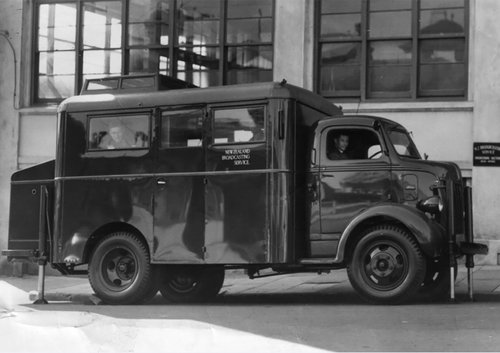
By Alex Porter and Camilla Wheeler (Ngā Taonga Sound & Vision)
In September this year Audio Conservator Alex Porter and Cataloguer Camilla Wheeler embarked on a project to digitise and describe the New Zealand Broadcasting Service Mobile Unit Collection. The project will take the best part of the next year, and in this time Alex and Camilla will listen to every part of the collection.
The Mobile Unit was one of the first mobile recording units in New Zealand. The origins of the Mobile Unit itself are as fascinating asthe contents of the collection. Set up after the Second World War, the purpose was initially to go out and record musical talent from the provinces for use in broadcast programmes for the radio – an early New Zealand’s Got Talent or X Factor. However, the scope of the mission broadened when the sound recordists realised the wealth of oral histories the old people of the towns they visited could contribute.
In post-war New Zealand, it was important to create radio programmes which had a patriotic appeal and showcased the best our country had to offer in order to increase morale. However, with limited budget and radio stations only existing in a few main centres, broadcasters were restricted to recording people, bands and choirs who could come into the studio. Professor Shelley, Director of Broadcasting, “had an idea that the country was simply ridden with talent which never got an opportunity of getting near a microphone”[1] and directed producer Leo Fowler to establish the Mobile Unit recording team. The brief was to record “the bands, the choirs, the school choirs, and the thousands of individual artists [in the provinces] who were just waiting to provide the Broadcasting Service with some new talent.”[2]
The bands and choirs they had been sent to record were often only available to record in the evenings, as they were made up of working men and women. This left the recording team with spare time in the day, during which they made calls on the local elderly and invited them to record their memories. Very quickly, they realised that here was the real gold. In the 1940s there were people alive who remembered the New Zealand wars in Waikato and Taranaki, and the gold rushes in Coromandel and Central Otago, with memories going as far back as the 1860s. The result was that these oral histories, which were initially the by-product of the project, came to be the focus of the Mobile Unit. The collection contains some of the oldest recorded memories of New Zealand, including some of the earliest recorded te reo speakers. Leo Fowler had good relations with Māori and made an effort to seek out te reo speakers and kaumātua.
The Mobile Unit vehicle itself – “Gerty,” as she was called – was “one of the mobile control towers belonging to the Air Force … [and] had four hydraulic jacks put on it, one at each corner”[3]. The purpose of the jacks was to make sure the van was absolutely level, no matter where it was parked. This was because the two 16” disc recorders it was equipped with were very sensitive to any movement. As well as the recording equipment, speakers and microphones, the van also contained an operating desk, interview table and general workbench. It had “five [or six] drums of cable so that you could record at considerable distances and [use up to] four or five microphones”[4] at a time.
Hero image - Mobile Recording Unit truck.
Listen to Geoff Hagget, Mobile Recording Unit Announcer (1947), as he describes the truck and crew in an NZBC interview, 17 April, 1973.
The resultant Mobile Unit Collection is one of the richest resources of oral history in New Zealand. It was recognised by UNESCO last year and inscribed onto the UNESCO Memory of the World register.
The original recordings are on lacquer discs, and are kept in archival crates in Ngā Taonga Sound & Vision’s audio archive in Christchurch. The collection was preserved in the early 2000s onto CD, which was the medium of choice at the time. However, we have since realised that CDs have a finite shelf life and therefore it is important that we preserve this valuable collection in digital format as well.
As part of the project, we will be making full descriptions of the recordings in our catalogue records. Please check back in the future to see what gems we have uncovered.
Read updates on preserving the Mobile Unit Collection:
Notes:
[1] Leo Fowler: Reminiscences on the Mobile Recording Unit. Transcript. Mobile Unit Collection, Ngā Taonga Sound & Vision.
[2] Ibid.
[3] Geoff Haggett: NZBS Mobile Unit. [Audio], Ngā Taonga Sound & Vision.
[4] Fowler